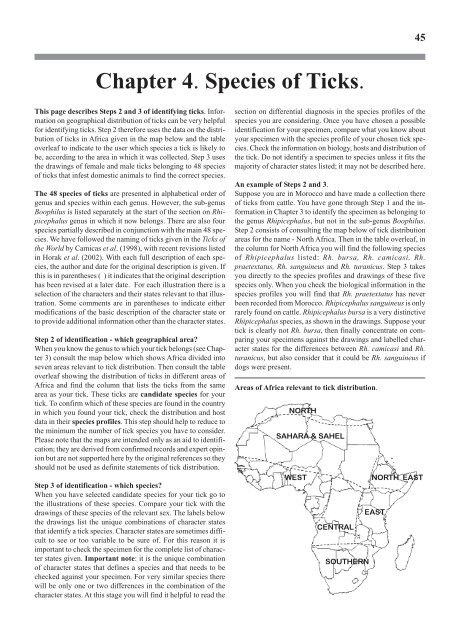Ticks of Domestic Animals in Africa - Alan R Walker - Science Writer
Ticks of Domestic Animals in Africa - Alan R Walker - Science Writer
Ticks of Domestic Animals in Africa - Alan R Walker - Science Writer
Create successful ePaper yourself
Turn your PDF publications into a flip-book with our unique Google optimized e-Paper software.
Chapter 4. Species <strong>of</strong> <strong>Ticks</strong>.<br />
This page describes Steps 2 and 3 <strong>of</strong> identify<strong>in</strong>g ticks. Information<br />
on geographical distribution <strong>of</strong> ticks can be very helpful<br />
for identify<strong>in</strong>g ticks. Step 2 therefore uses the data on the distribution<br />
<strong>of</strong> ticks <strong>in</strong> <strong>Africa</strong> given <strong>in</strong> the map below and the table<br />
overleaf to <strong>in</strong>dicate to the user which species a tick is likely to<br />
be, accord<strong>in</strong>g to the area <strong>in</strong> which it was collected. Step 3 uses<br />
the draw<strong>in</strong>gs <strong>of</strong> female and male ticks belong<strong>in</strong>g to 48 species<br />
<strong>of</strong> ticks that <strong>in</strong>fest domestic animals to f<strong>in</strong>d the correct species.<br />
The 48 species <strong>of</strong> ticks are presented <strong>in</strong> alphabetical order <strong>of</strong><br />
genus and species with<strong>in</strong> each genus. However, the sub-genus<br />
Boophilus is listed separately at the start <strong>of</strong> the section on Rhipicephalus<br />
genus <strong>in</strong> which it now belongs. There are also four<br />
species partially described <strong>in</strong> conjunction with the ma<strong>in</strong> 48 species.<br />
We have followed the nam<strong>in</strong>g <strong>of</strong> ticks given <strong>in</strong> the <strong>Ticks</strong> <strong>of</strong><br />
the World by Camicas et al. (1998), with recent revisions listed<br />
<strong>in</strong> Horak et al. (2002). With each full description <strong>of</strong> each species,<br />
the author and date for the orig<strong>in</strong>al description is given. If<br />
this is <strong>in</strong> parentheses ( ) it <strong>in</strong>dicates that the orig<strong>in</strong>al description<br />
has been revised at a later date. For each illustration there is a<br />
selection <strong>of</strong> the characters and their states relevant to that illustration.<br />
Some comments are <strong>in</strong> parentheses to <strong>in</strong>dicate either<br />
modifications <strong>of</strong> the basic description <strong>of</strong> the character state or<br />
to provide additional <strong>in</strong>formation other than the character states.<br />
Step 2 <strong>of</strong> identification - which geographical area?<br />
When you know the genus to which your tick belongs (see Chapter<br />
3) consult the map below which shows <strong>Africa</strong> divided <strong>in</strong>to<br />
seven areas relevant to tick distribution. Then consult the table<br />
overleaf show<strong>in</strong>g the distribution <strong>of</strong> ticks <strong>in</strong> different areas <strong>of</strong><br />
<strong>Africa</strong> and f<strong>in</strong>d the column that lists the ticks from the same<br />
area as your tick. These ticks are candidate species for your<br />
tick. To confirm which <strong>of</strong> these species are found <strong>in</strong> the country<br />
<strong>in</strong> which you found your tick, check the distribution and host<br />
data <strong>in</strong> their species pr<strong>of</strong>iles. This step should help to reduce to<br />
the m<strong>in</strong>imum the number <strong>of</strong> tick species you have to consider.<br />
Please note that the maps are <strong>in</strong>tended only as an aid to identification;<br />
they are derived from confirmed records and expert op<strong>in</strong>ion<br />
but are not supported here by the orig<strong>in</strong>al references so they<br />
should not be used as def<strong>in</strong>ite statements <strong>of</strong> tick distribution.<br />
Step 3 <strong>of</strong> identification - which species?<br />
When you have selected candidate species for your tick go to<br />
the illustrations <strong>of</strong> these species. Compare your tick with the<br />
draw<strong>in</strong>gs <strong>of</strong> these species <strong>of</strong> the relevant sex. The labels below<br />
the draw<strong>in</strong>gs list the unique comb<strong>in</strong>ations <strong>of</strong> character states<br />
that identify a tick species. Character states are sometimes difficult<br />
to see or too variable to be sure <strong>of</strong>. For this reason it is<br />
important to check the specimen for the complete list <strong>of</strong> character<br />
states given. Important note: it is the unique comb<strong>in</strong>ation<br />
<strong>of</strong> character states that def<strong>in</strong>es a species and that needs to be<br />
checked aga<strong>in</strong>st your specimen. For very similar species there<br />
will be only one or two differences <strong>in</strong> the comb<strong>in</strong>ation <strong>of</strong> the<br />
character states. At this stage you will f<strong>in</strong>d it helpful to read the<br />
Areas <strong>of</strong> <strong>Africa</strong> relevant to tick distribution.<br />
NORTH<br />
SAHARA & SAHEL<br />
45<br />
section on differential diagnosis <strong>in</strong> the species pr<strong>of</strong>iles <strong>of</strong> the<br />
species you are consider<strong>in</strong>g. Once you have chosen a possible<br />
identification for your specimen, compare what you know about<br />
your specimen with the species pr<strong>of</strong>ile <strong>of</strong> your chosen tick species.<br />
Check the <strong>in</strong>formation on biology, hosts and distribution <strong>of</strong><br />
the tick. Do not identify a specimen to species unless it fits the<br />
majority <strong>of</strong> character states listed; it may not be described here.<br />
An example <strong>of</strong> Steps 2 and 3.<br />
Suppose you are <strong>in</strong> Morocco and have made a collection there<br />
<strong>of</strong> ticks from cattle. You have gone through Step 1 and the <strong>in</strong>formation<br />
<strong>in</strong> Chapter 3 to identify the specimen as belong<strong>in</strong>g to<br />
the genus Rhipicephalus, but not <strong>in</strong> the sub-genus Boophilus.<br />
Step 2 consists <strong>of</strong> consult<strong>in</strong>g the map below <strong>of</strong> tick distribution<br />
areas for the name - North <strong>Africa</strong>. Then <strong>in</strong> the table overleaf, <strong>in</strong><br />
the column for North <strong>Africa</strong> you will f<strong>in</strong>d the follow<strong>in</strong>g species<br />
<strong>of</strong> Rhipicephalus listed: Rh. bursa, Rh. camicasi, Rh.<br />
praetextatus, Rh. sangu<strong>in</strong>eus and Rh. turanicus. Step 3 takes<br />
you directly to the species pr<strong>of</strong>iles and draw<strong>in</strong>gs <strong>of</strong> these five<br />
species only. When you check the biological <strong>in</strong>formation <strong>in</strong> the<br />
species pr<strong>of</strong>iles you will f<strong>in</strong>d that Rh. praetextatus has never<br />
been recorded from Morocco. Rhipicephalus sangu<strong>in</strong>eus is only<br />
rarely found on cattle. Rhipicephalus bursa is a very dist<strong>in</strong>ctive<br />
Rhipicephalus species, as shown <strong>in</strong> the draw<strong>in</strong>gs. Suppose your<br />
tick is clearly not Rh. bursa, then f<strong>in</strong>ally concentrate on compar<strong>in</strong>g<br />
your specimens aga<strong>in</strong>st the draw<strong>in</strong>gs and labelled character<br />
states for the differences between Rh. camicasi and Rh.<br />
turanicus, but also consider that it could be Rh. sangu<strong>in</strong>eus if<br />
dogs were present.<br />
WEST NORTH EAST<br />
CENTRAL<br />
SOUTHERN<br />
EAST


